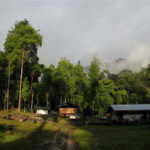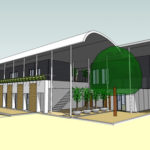Prof. Ho
When I first met Prof Ho Coy Choke he was hunched over his plate clumsily shoveling rice into his mouth. He spoke in a loud abrupt tone without looking up. Once his meal was finished he straightened up, slid a pair of heavy rimmed glasses onto his nose and transferred his attention to me. I tried hard to return the scrutiny but between his heavily squinted eyebrows I was not even able to determine the colour of his pupils. That he was a man of powerful intellect was immediately apparent by the chain of his questions. That he loved talking about his work to someone who was interested was equally obvious.He works at Universiti Malaysia Sabah in the department of biotechnology. I have mentioned that one of the many values that we can place on the rainforest is the chance that there might be something useful to us there. My conversations with Prof Ho were my first first-hand evidence of this in practice.
On this visit he had brought a group of students to research correlation between tree diversity and microbe diversity. Microbes are essential to the ‘decomposition’ stage of the nutrient cycle. In a tropical rainforest very few nutrients are stored in the soil, instead they are cycled endlessly between the dead and the living using the processes of composition and decomposition.
Prof Ho explained that different kinds of dead things will be decomposed by different types of microbes. He is therefore looking for rare trees and in particular byproducts such as resin that are difficult to decompose. It seems reasonable to me to accept his assertion that these in these environments you might find extraordinary microbes.
The microbes in question are mostly bacteria and yeast type fungi. What Prof Ho is so excited about is that these microbes produce complex chemical compounds that may be useful to medical science. For example there is a compound called avermectin that is partially effective against incurable nematode infections such as elephantiasis and river blindness. This was originally found in Japanese soil and is now being synthesised commercially. In Sabah Prof. Ho has personally isolated a compound from lowland dipterocarp forest soil that is finding applications in cancer research. I would love to explain more but the science gets a bit beyond me at this point.
What I did understand is that the more rare the microbes, the more unusual and potentially useful their chemical byproducts are likely to be. The fact that the rainforests are quickly disappearing is of great concern to Prof. Ho. This is because microbes evolve something like an order of magnitude faster than larger plants and animals so any changes in ecosystem are going to become apparent at the microscopic level first.
Prof. Ho is therefore on a mission to find stuff that no one else has found in the hope that it might prove valuable both to his reputation, to medical research and to the survival of primary forests in Borneo.
Related Posts







Hi Mr Ian Hall,
I do not know if you will ever visit this blog again, but just wish to tell you that your description of Prof Ho is just impeccable, and you definitely can take my word for it because I have been working with Prof Ho (together with 3 other colleagues) for over four years; bioprospecting rainforest microbes. Lastly, good luck and keep up the good work (whatever it may be). – FSH